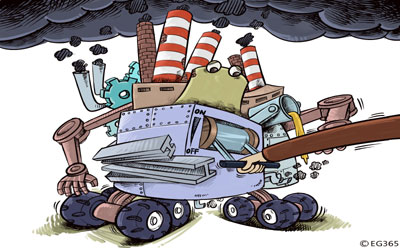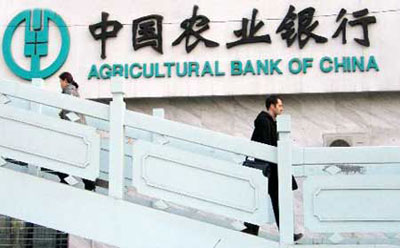

Highlights from the EO print edition, Issue Wrap No. 488, September 27
Property Tax Pilot to take place in Shenzhen and Hangzhou
News, cover
~ The Chinese government held an international conference to discuss potential policy changes concerning property tax. Half of the 68 attendees work for China’s taxation departments or departments dealing with land and resources.
~At the conference, officials from Shenzhen and Hangzhou city governments shared proposals for the new property tax. The two cities are likely to be the first to pilot the tax.
~The EO has learned from the Beijing Tax Bureau that the property tax may be piloted as early as the end of this year and will officially take effect in the coming year.
~ However, problems remain. Some local governments are worried about losing competitiveness if their cities impose a property tax. Additionally, many assume that the property tax will help cool down the inflated property market but worry about its long-term impact if the property market takes a downturn.
Original article: [Chinese]
New Company Set to Manage High-speed Railway Debt and Investment
News, cover
~ The Ministry of Railways is planning to establish a new company to manage the debt and the share-holding structure of investment in high-speed railways.
~A report by China Minsheng Bank reveals that in total, the Ministry of Railways has over one trillion yuan in debt and its payments are expected to peak in 2014.
~ Since 2006, the Ministry of Railways has invested over one trillion yuan in constructing and operating high-speed railways. But most of the railways have been suffering losses. The high-speed railway connecting Beijing and Shanghai will suffer a loss of 300 million yuan this year.
Original article: [Chinese]
Ministry of Commerce’s Platform to Increase Imports Being Considered
News, page 3
-The draft of a Ministry of Commerce proposal for further regulations to increase imports is essentially complete and awaiting consideration by related agencies. Upon favorable consultations with the other agencies, the regulations will need approval by the State Council.
-The Chinese government already adopted a plan to increase imports earlier this year. The fledgling program included a reduction of important tariffs on raw materials and finished goods, zero tariffs on imports from the world’s least developed nations, and tariff and value-added tax exemptions for crucial science, technology, and tool imports.
-The Ministry of Commerce’s newly proposed program would target even more industries by adopting four main strategies. First, the ministry suggests provisional tariff reductions to bring the total tariff level even lower than the current 9.8%. Second, efforts would be made to simplify import procedures and to make clearing customs more convenient. Third, commodity quotas would be increased and import licensing decentralized. Finally, the highlight of the proposal is to provide financing to domestic importers and foreign exporters.
-Financing would be provided cheaply through import-export banks, discounts on government interest rates, or via corporate guarantees of export credit insurance. The abovementioned source added that financing would be directed towards certain countries and domestic importers and that the monetary value of the financing is still under consideration.
Original article: [Chinese]
Government-subsidized Housing Lacks Mature Finance Model
News, page 4
~ Although the Chinese government is determined to construct government-subsidized housing on a large scale, many doubt whether the construction plans will be realized on time. So far, there is no long-term finance model to pay for them.
~ Currently, most government-subsidized housing is supported by local financial revenue. But this model cannot last long because most local governments operate on a tight budget.
~ Without a long-term finance model, most government-subsidized housing projects will have to stop, leaving the plots of land idle, risking the transfer of the land to commercial housing by local governments.
~Officials from the banking system have suggested that local governments provide a financial guarantee for these policy-based housing projects, but the suggestion has yet to be considered.
Original article: [Chinese]
Ministry of Finance: Social Insurance Payments to Increase to 25% of Expenditure
News, page 5
~ The Ministry of Finance (MOF) has urged financial departments at all levels to increase the investment in social insurance during the period of the coming 12th Five-Year Plan period (2011-2015).
~ Ministry officials have requested that financial departments increase expenditure on social insurance from the current 10% of total outlays to approximately 25% of total expenditure.
~ The MOF is also encouraging broader social insurance coverage in order to achieve social insurance for all.
~ This also involves increasing the payments and coverage in rural areas in order to narrow the gap between the level of social security afforded to urban and rural residents.
~ Over recent years, payouts by the social insurance fund have been increasing more rapidly than the growth in revenue. The MOF will take various measures to reduce the potential financial risks posed by this situation.
~ Dividends paid to the central government by centrally-controlled state-owned enterprises and revenue raised by the leasing of government-owned land are likely to be two main sources of the additional revenue required to cover the large increase in social security outlays.
Original article: [Chinese]

Local Governments Ruling with “Iron Fist” to Reduce Harmful Emissions
News, page 6
~Last year, the State did everything to ensure a sustained 8% GDP growth. This year, it is putting its efforts into reducing harmful emissions.
~The State Council ordered the National Development and Reform Commission and other relevant departments to form a Six Joint-Inspection Unit. The unit will implement and oversee efforts to reduce carbon emissions in Hebei, Zhejiang, Liaoning, Shandong, and 18 other provinces.
~ Chengde Iron and Steel Group in Hebei has a production capacity of more than 500 million tons. It has closed down four steel companies, with a total capacity of 160 million tons, and seven cement production companies. It is also experimenting with wind power.
~But for the local government, this is not enough. Chengde fears it will become the “sacrificial lamb” of the country’s energy-saving measures.
~In Wuan in Hebei Province, 18 enterprises have had their power cut. Wang Dayong, an official from the Hebei Metallurgical Industry Association, says that at current prices, the local steel industry will lose over 60 billion yuan from the factory shut-downs.
~According to reports, despite the shut-downs, employees are required to show up to work in order to prevent worker protests and other disturbances.
~Liaoning, Zhejiang, and other provinces are also implementing energy saving measures such as electricity quotas, rolling blackouts, and increased use of wind power.
~From 2006-2009, energy consumption per unit of GDP decreased by 14.38%, but it increased in the first half of this year.
~State inspectors expect harmful emissions can be reduced by 20% by 2010, but it will be difficult to sustain an 8% GDP growth at the same time.
~There are also problems with implementing the measures. In certain places, residential areas experience rolling blackouts along with industrial zones, and there is no distinction between energy used for industry and energy intended for basic services.
~State Inspectors recommend that future measures take into account not only production capacity and emissions, but the state of local economic development and the circumstances of the companies effected.
Original article: [Chinese]

Agricultural Bank of China Applying for Lower Reserve Ratio
Market, page 19
~ The Economic Observer has learned from officials that the Agricultural Bank of China Ltd is looking to the central bank to lower the reserve ratio requirement for banking businesses in rural areas.
~The bank is currently required by the government to have a 17% reserve ratio.
~It is applying to lower the ratio to somewhere between 11% and 15% for over 2000 branches.
~The central bank has agreed in principle to the application, but the relevant monetary policies have to be further discussed.
Original article:[Chinese]
Stories Behind Taizinai’s Bankruptcy
Corporation, page 25
~ Private equity (PE) investors can register a company in the British Virgin Islands (BVI) and then purchase the targeted companies as a BVI Company. This type of shareholding structure will make things too complicated to resolve if disputes amongst different shareholders occur.
~ The Taizinai Company, a dairy company originally located in Zhuzhou city in Hunan Province, is a good example.
~ At the end of 2009, in order to have Taizinai listed on the stock market, Li Tuchun, founder of Taizinai, invited CDC Group, Goldman Sachs and Mogen Stanley to invest in his company. The four co-founded China TZE Holding Company and had registered it in the BVI. This new company controls all the Taizinai companies across China through three direct subsidiaries. Li and his team hold 70% of the shares of new company.
~Taizinai’s debtors include the Shanghai branches of the Royal Bank of Scotland, Citibank, the Construction Bank of China and the Beijing government.
Original article: [Chinese]
Ministry of Finance to Supervise Ministry-affiliated COEs
EO Online
~On September 26, the Ministry of Finance (MOF) released a notice concerning over 6000 centrally owned enterprises. This notice emphasizes that ministry-affiliated COEs will be supervised and managed by the MOF, Administrative Politics and Law Department, and the Department of Education and Sciences, respectively according to their specific shareholders.
~In fact, the MOF has been the supervisory body of ministerial centrally-owned enterprises, but since the original National Capital Bureau has been disbanded, and over 100 centrally-owned enterprises were incorporated into the supervision of the SASAC, the supervision of centrally-owned enterprises affiliated with the MOF and other central ministries has been weakening, so much so that supervision of them has seemed to have come to a halt.
~In 2006 the MOF issued "Interim Measures for Administration of State Assets Management Unit" (MOF Order No. 35) and "Interim Measures on Management of State Assets and Institutions" (MOF Order No. 36) which both emphasized that the MOF would supervise central enterprises and institutions and their respective state-owned assets.
~Since the issue of the two orders, the supervision duties have not been assigned to a specific department or office and it has not been determined who will supervise enterprise funds.
Original article: [Chinese]
Huadian Group’s “Prisoner’s Dilemma”
Corporation, page 29
~On September 21, Huadian Energy announced that it would pay 1.17 billion yuan to acquire a 100% stake in Heilongjiang Fulaerji Power Generation, a 15.28% stake in Harbin Thermoelectric and a 1.6% stake in Qiqihar Thermoelectric
~Sources close to the group say that the purchase was made to eliminate Huadian Energy’s competition in the Northwest. Additionally, sources working for KPMG audit stated that the acquisition may help ease Huadian’s losses, if not improve other statistics in their accounting statements.
~In first half of this year, Huadian Group’s losses surpassed 450 million yuan, an early default on a previously stated target of 25 billion yuan in profits for the year. The most cited reason for poor performance in the power generating industry has been rapidly rising coal prices. In fact, in the first half of this year, only 3 of the 5 largest energy generating companies posted a profit, with the highest reported profit being only 2.274 billion yuan.
~Wang Yan of Puyuan Linyang Investment Company told reporters that energy companies rely on society to increase energy consumption and thus lessen the impact of coal prices. However, energy consumption has recently been declining, thus failing to decrease losses for power generating companies.
~Wang Yan argues that energy companies need to stop relying on government action and address the real issue of the coal industry’s prisoner’s dilemma pricing. Huadian Energy’s recent purchase of stakes in alternative energy companies is one way to lessen the blow of steep coal prices, but alternative energy sources are also higher risk.
Original article: [Chinese]

